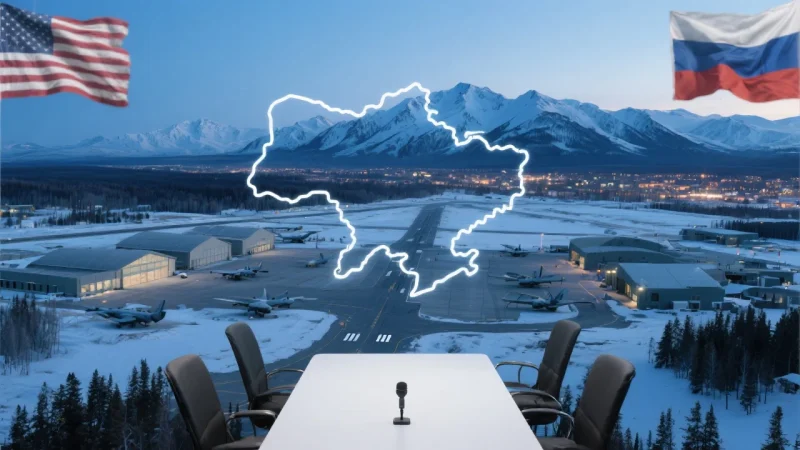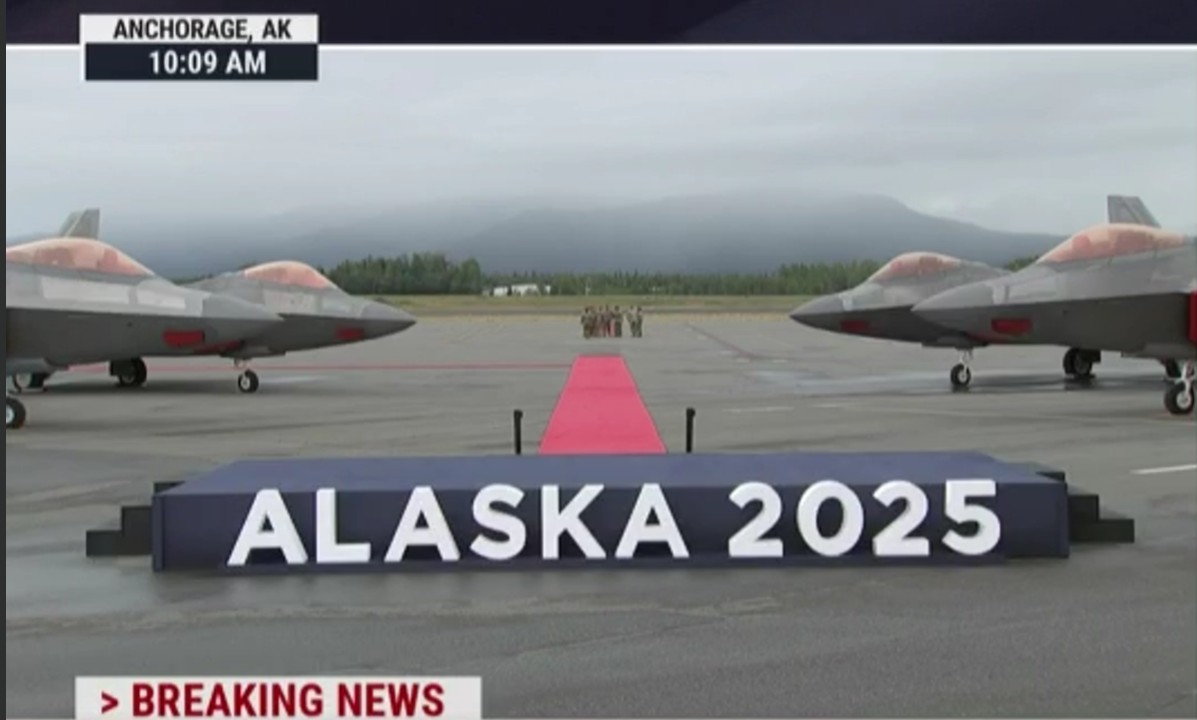

A meeting on America’s edge with consequences at the center
An American president is flying to the only state the United States ever bought from Russia, to meet the Russian leader at a Cold War sentinel of a base, and talk about how to stop a hot war in Europe.
That sentence reads like political fan fiction. It is also the reality in Anchorage, where President Trump and Vladimir Putin are expected to sit down at Joint Base Elmendorf‑Richardson to discuss Ukraine and the outlines of a possible ceasefire, with no Ukrainian seat at the table and few advisers in the room. The venue and the format tell a story before a single word is spoken. The symbolism of Alaska and the solitude of a largely one‑on‑one conversation raise the core question animating Washington, Kyiv, Moscow, and Europe: which Trump is about to walk into that room?
The White House has signaled a restrained agenda and cast the encounter as a listening session. Officials describe an exploratory meeting more than a grand bargain. Reporting has set expectations for a location and context heavy with history and irony. The base was built to deter the Soviet Union and now hosts two leaders confronting a war launched by its successor state. The BBC details why Alaska was chosen and what the base represents in American strategy and mythology, a literal first line of defense turned diplomatic stage. The Associated Press echoes the Cold War lineage and the uncomfortable optics of discussing European borders at a facility designed to counter Moscow.
The meeting Trump says he can shape in minutes
Trump has long promised he can end the war quickly. That confidence has become a kind of policy, with the president openly musing about “swapping” land to get to a ceasefire, then insisting he will try to claw back territory for Ukraine. It is a fog of posture and improvisation that keeps allies anxious and adversaries probing. The Guardian captures the emotional whiplash of Trump‑Putin meetings past, recalling Helsinki in 2018 and the way an off‑script president can unsettle Washington’s entire national security apparatus. Experts quoted there warn that a private session with minimal staff can produce confusion, mixed signals, and claims of “agreements” that evaporate on contact with bureaucracy or reality.
If you zoom out, the stakes are obvious. Ukraine is not in the room. European leaders are not in the room. Putin is. PBS and The Washington Post outline the Russian wish list that has not changed, from neutralizing Ukraine to freezing current lines in ways that entrench Moscow’s territorial gains. CNN reports Putin is dangling a nuclear arms control conversation, the sort of framing that flatters American presidents and hints at legacy, even as the central battlefield remains the Donbas and southern Ukraine.
Two Putins, two Trumps
We know the two Putins. The one who arrives as a tactician, offering narrowly transactional deals with maximal strategic payoff. And the one who plays for the camera, praising his counterpart’s “energy,” as he did this week, while keeping his red lines intact. We also know the two Trumps. The dealmaker who likes to shock the room into movement, and the showman who measures success by headlines and atmospherics. Allies are trying to game out which one dominates. If Trump the transactionalist shows up, he will try to get something specific to carry back to Kyiv and Brussels. If Trump the showman shows up, he will seek the optics of momentum and the script of inevitability. One path courts real risks for Ukraine’s sovereignty. The other risks another Helsinki, all sizzle, little steak, and a trail of cleanup memos.
A former senior official once described to me the choreography of a Trump high‑stakes meeting as a three‑act play. Act I opens with flattery and personal rapport. Act II features a surprise proposal delivered with absolute confidence. Act III ends with a fog of contradictions that staff scramble to reconcile. That pattern is not destiny, but it is muscle memory. The Guardian’s account of Fiona Hill eyeing a fire alarm in Helsinki reads like a stage direction from the last production.
The Alaska frame
Anchorage offers a very specific frame. It is closer to Russia than any other major American city and home to an installation that once watched the skies for Soviet bombers. It is also a reminder of American geography. The United States and Russia are literal neighbors. That reality has always demanded channels that can handle crisis as well as opportunity. BBC’s ground notes on Joint Base Elmendorf‑Richardson, from its Cold War radar fields to its modern Arctic mission, underline the paradox of a deterrence site hosting a negotiation over borders and war.
The symbolism cuts both ways for Putin. Meeting on American soil, without Ukraine, can be packaged for domestic consumption as global relevance restored. Meeting at a U.S. base, under American security protocols, is a reminder that Russian leverage has limits. For Trump, Alaska offers the theater of presidential seriousness and the promise that proximity itself will exude control.
What would a “deal” actually mean?
Strip away the theater and you hit three questions. First, where do the lines stop. Any ceasefire that ratifies Russian control over occupied territory, including Crimea and much of Donbas, would be billed by the Kremlin as victory. Ukraine’s leadership has rejected territorial trades as a durable path to peace. Second, what security guarantees matter. A paper promise will not deter a second invasion. A material guarantee requires sustained Western unity, the opposite of a one‑leader gambit. Third, what offsets can be traded. Sanctions relief, energy flows, prisoner exchanges, nuclear thresholds. Putin has floated nuclear arms talk as a side door to bigger concessions.
The BBC and PBS coverage captures how the administration has floated versions of a ceasefire that freeze the conflict while reshuffling control across regions. Those trial balloons have already collided with the reality that Ukrainians are the ones dying and fighting, and that European security does not get stronger by normalizing conquest.
The Ezra question and the Kara question
Ezra’s question is the systems one. What incentives are we creating now that will structure behavior later. A ceasefire that rewards aggression invites the next one. A process that sidelines the invaded country weakens the norm that borders cannot be changed by force. A negotiation that ties U.S. policy to personality increases the variance of outcomes. The Alaska summit is not just about what happens Friday. It is about what happens in five years when another leader looks at the map and decides what they can take.
Kara’s question is the power one. Who is holding the leverage in the room. The answer is not just Putin versus Trump. It is also Trump versus his own staff and allies, and Putin versus his domestic constraints. A leader who wants the clip more than the clause can get worked. A leader who wants the clause more than the clip can overreach. The durable version of American power has always been the coalition and the process. The brittle version is the improv.
Which Trump will show up
The first‑five‑minutes test that Trump loves is about posture, not structure. Putin will come prepared to sell Trump on the image of a peacemaking presidency. The lasting test is whether Trump can translate that into a framework that strengthens deterrence and does not sacrifice Ukrainian sovereignty by euphemism. If the president who trusts instincts over briefings arrives, expect newsy lines, few footnotes, and a weekend of parsing. If the president who senses when the other side needs him more than he needs them shows up, expect a careful statement, a narrow deliverable, and a second meeting with Ukraine included.
The measure is not whether there is a handshake in Alaska. It is whether Kyiv’s bargaining position is stronger the morning after.
What to watch for in the readout
Listen for four tells. One, how specific the ceasefire language is about lines and verification. Two, whether nuclear arms control gets elevated as a headline at the expense of battlefield realities. Three, any mention of European coordination, which signals process over spectacle. Four, clarity on Ukraine’s inclusion in next steps. The Washington Post notes that Putin has resisted the very ceasefires the White House hopes to elicit. If that resistance survives Anchorage, the show will have been the point.
The bottom line
Alaska is a stage, not a solution. The real work begins if the principals can move from theater to terms, and from terms to enforcement. Until then, the most honest answer to the headline question is also the most unsettling. We will only know which Trump showed up when we hear which Ukraine is imagined in his deal.
